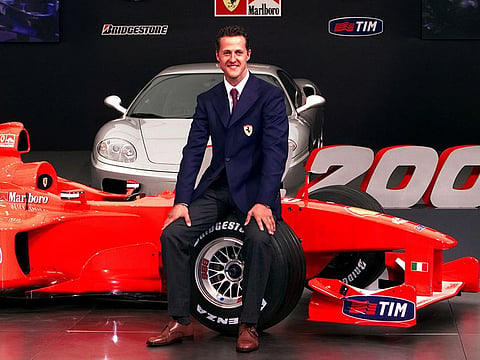Michael Schumacher’s $9.5 million F1 Ferrari is tip of valuable car market
Collectors are now paying attention to obscure world of decommissioned race cars

Hong Kong: On April 12, an old Ferrari that Michael Schumacher drove to his first Formula 1 World Championship in 2000 sold for an undisclosed amount at a private auction in Hong Kong. The lightweight land rocket, a Ferrari F1-2000, had brought the racing team its first world title in more than two decades, and it set up Schumacher to win four additional championships with Ferrari in the following consecutive years.
Initial estimates valued the car at $7.5 million to $9.5 million, a spokesperson for Sotheby’s confirmed “An elite sum that won’t surprise anyone who pays attention to the obscure world of decommissioned race cars. Once disregarded as useless and undriveable relics, old racers are gaining traction in the ultra-niche world of high-end car collecting.
Racing history
“These cars used to be really difficult to sell, and people were scared off by them,” says Andrew Olson, a specialist for RM Sotheby’s. “Now, people are recognising their historic importance and their racing history, and their significance is finally being appreciated.”
It’s admittedly rare air. But for folks who already have everything in their garage “Ferrari F40s and Porsche 930 Turbos and Mercedes-Benz gullwings” a real race car is the next must-have.
The Ultimate Driving Experience
Discarded race cars are more than just unusual-looking vehicles with zippy stripes or logos painted on them and without air conditioning and radio. These are cars built to meet the unique requirements of a particular racing series such as Indy Car, Can-Am, Nascar and Formula 1, 2 or 3. They come with things like roll cages and slick racing tires but typically lack such mundane conveniences as rear-view mirrors and passenger seats. They are not legal to drive on regular streets and roads.
Decommissioned relics have been around as long as car races. Automakers from BMW and Mercedes to Ferrari and Lotus might keep a few in company archives and brand museums, but many are deconstructed, left in shambles or sold to private collectors. Last year, cash-strapped McLaren sold several of the cars in its F1 heritage collection in order to raise money to develop its Artura hybrid.
Powerful allure
Often expensive to maintain “expect to shell out from $250,000 to $500,000 to get an old F1 Ferrari back into running order,” Olson says “and difficult to drive, even for people used to driving old cars, they can languish in museums or back garages. They might be trotted out once or twice a year for an auto festival or a parade lap among the most arcane circles of car fanciers." But they hold a powerful allure for those who love them, such as Art Hebert, who sells them via Motorsports Market.
“I was very typical as a kid, lusting after beautiful Ferraris and Jaguars but could never afford them,” says Hebert, who founded the San Rafael, California-based company in 1998. “As time goes on, you raise your kids and they become self-supporting. You start thinking about: Now that I don’t have all this cash going out, I’ve got an opportunity to relive those moments I wanted as a kid. So we buy these cars Mario Andretti or Michael Schumacher raced, and we get to have that thrill, the rush, of what it must have been like to be Schumacher at the Grand Prix “and winning.”
“It’s not uncommon for people who own the old Ferrari F1 cars to drive them on the track,” Olson says. “It’s the ultimate driving experience.”
Undervalued Assets
The cars’ relative obscurity has been punctuated by several big sales in recent years. In 2017, Sotheby’s sold Schumacher’s Monaco Grand Prix-winning Ferrari F2001 for a record $7.5 million. The auction house had orchestrated a big marketing campaign to drum up excitement for the car, and it worked, Olson says. By 2022, another Schumacher Ferrari, a F2003-GA, sold for nearly $15 million at Sotheby’s sale in Geneva, virtually doubling the 2017 total as the modern era’s biggest public payment for an F1 car.
The upward climb across the segment continued this year at the annual auctions in Florida, where a bright teal-coloured 1987 Kremer Porsche 962C sold for $907,000, beating a low estimate of $850,000, and a white-striped 1959 Lister-Chevrolet Sports Racer sold for $423,000 against a low estimate of $400,000.
Extreme rarity
There’s plenty of room for growth in the still largely undiscovered market. Vintage race cars remain largely undervalued because current prices don’t accurately reflect racing pedigrees, histories and extreme rarity.
“Why should a Ferrari F50 be worth only half the price of a Grand Prix-winning Schumacher F1 car? They built 350 Ferrari F50s, but they built eight Ferrari F-2000s,” says Olson. “I wouldn’t be surprised at all if five years from now the gap between great road cars and great Formula 1 cars has continued to widen.”
Sign up for the Daily Briefing
Get the latest news and updates straight to your inbox



